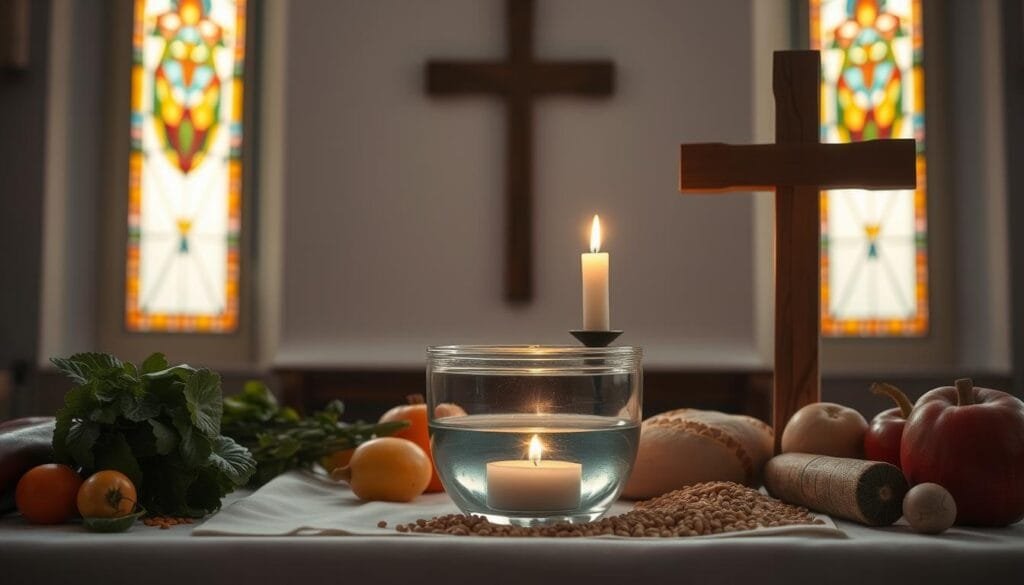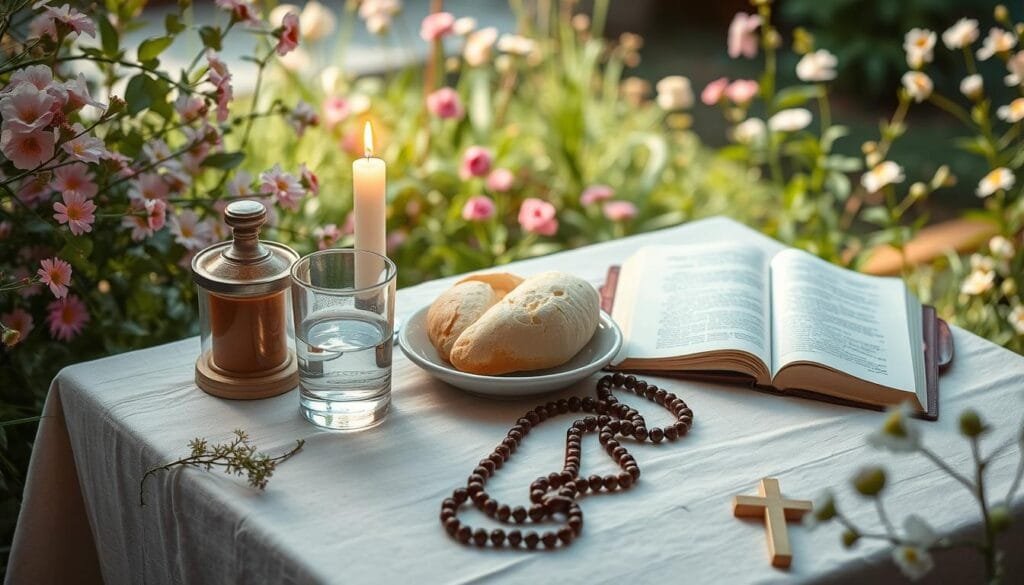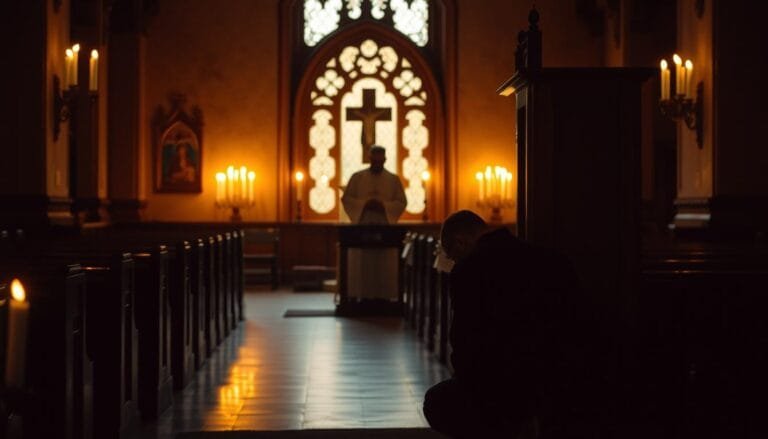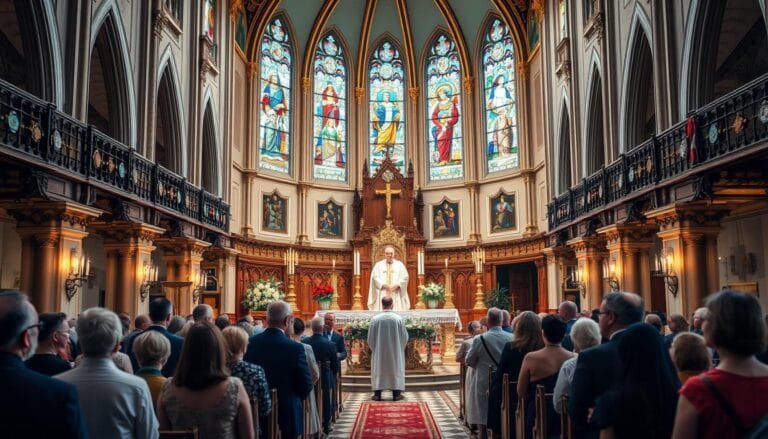Catholic Fasting Guide: Ancient Practice for Modern Faith
This website contains affiliate links. As an Amazon Associate, I earn from qualifying purchases. The content on this website was created with the help of AI.
Each year, over 1 billion Catholics embrace the sacred tradition of fasting, extending beyond Lent into a year-round spiritual practice.
Our comprehensive Catholic fasting guide illuminates this ancient discipline for contemporary believers.
We’ll explore the essential rules, various forms of fasting, and practical ways to integrate this practice into your spiritual life.
From bread-and-water fasts to traditional Lenten observances, you’ll discover how this powerful tradition can transform your relationship with God.
Whether you’re new to fasting or seeking to deepen your practice, this guide provides the foundation for developing a meaningful and sustainable fasting discipline.
Key Takeaways
- Start with a bread and water fast for one meal, one day a week
- Increase fasting discipline gradually, such as fast multiple meals on a fast day or multiple days a week
- Drink water frequently during fasting to stay hydrated
- End the fast day with a normal-sized meal eaten slowly and mindfully
- Persevere through the difficulties of fasting for spiritual growth
- Explore the different types of Catholic fasts and required fasting days
The Sacred Tradition of Catholic Fasting
Catholic fasting has a long history, starting with Jesus’ 40-day fast in the wilderness. This tradition is a big part of Catholic spirituality.
Spiritual fasting is a key part of it. We fast to discipline ourselves, follow Christ, and get closer to God.
Looking back, Catholic fasting has changed over time. It started with early Christian fasting and abstinence.
Now, we follow fasting rules catholic during Lent. Many abstain from meat on Fridays and fast on Ash Wednesday and Good Friday.
Biblical Origins of Fasting
The Bible shows us the roots of Catholic fasting. We see Moses and Elijah fasting in the Old Testament.
And Jesus fasted for 40 days in the New Testament. These stories highlight the role of spiritual fasting in our faith.
Development Through Church History
As the Church grew, so did fasting. Early Christians fasted on Wednesdays and Fridays. Today, Catholics worldwide follow fasting rules Catholic. Many include spiritual fasting in their daily lives.
Why We Fast: The Spiritual Purpose
Throughout history, Christians have embraced fasting as a way to grow closer to God.
From our early brothers and sisters who fasted on Wednesdays and Fridays, to modern Catholics incorporating this practice into daily life, this ancient tradition continues to deepen our faith.
The Church sees spiritual fasting as a key to a stronger spiritual life. It helps us overcome selfishness, resist temptation, and improve self-control.
Fasting also helps us grow in patience, quiet our inner selves, and become more grateful.
Here are some tips for successful fasting:
- Fasting from technology one day a week
- Fasting from soda or skipping a meal once a week
- Fasting from sin and denying oneself dessert on specific days
When we practice prayer and fasting, we remember that grace is key. Combining these practices helps us deepen our bond with God and grow in faith.
| Spiritual Benefits of Fasting | Description |
|---|---|
| Quieting the inner self | Gaining control over physical desires and growing in gratitude |
| Gaining strength to endure difficulties | Preparing oneself to receive God and growing in patience |
Jesus fasting in the desert while praying shows the link between fasting and prayer. It stresses the importance of these practices together to deepen our bond with God.
A Complete Catholic Fasting Guide for Today’s Faithful
Catholics are called to fast and abstain on certain days. The Catholic fasting guide helps us follow these traditions. It says that those 18 to 59 must fast on Ash Wednesday and Good Friday.

There are various types of Catholic fasts. These include:
- Black fasting, where you don’t eat or drink anything
- The Passion Fast, where you give up certain foods or activities
- Xerophagiae, where you only eat dry foods
Catholics also must not eat meat on Ash Wednesday, Good Friday, and all Lent Fridays.
By following the Catholic fasting guide, we can deepen our faith. It helps us grow closer to God. Whether you’re new or have been practicing for years, the Catholic fasting guide is invaluable.
| Day | Type of Fast | Requirements |
|---|---|---|
| Ash Wednesday | Fast and Abstinence | One full meal, with some food permitted at breakfast and midday or evening |
| Good Friday | Fast and Abstinence | One full meal, with some food permitted at breakfast and midday or evening |
| Fridays of Lent | Abstinence | No meat, but eggs, milk products, and condiments made of animal fat are allowed |
Uniting Prayer and Fasting in Catholic Practice
Exploring prayer and fasting in Catholic practice shows they are closely linked. By combining spiritual fasting with prayer, we grow closer to God.
The United States Conference of Catholic Bishops says Catholics should not eat meat on Ash Wednesday, all Fridays in Lent, and Good Friday.
For more on prayer and fasting, check out this online guide. It shares the value of these practices and gives tips for daily life.
Important points for prayer and fasting include:
- Setting aside dedicated time for prayer and reflection
- Choosing a specific intention or focus for our fasting and prayer
- Being mindful of our physical and emotional limitations when fasting
Embracing spiritual fasting and prayer and fasting deepens our faith. They help us feel humble and rely on God’s guidance.
Let’s use these disciplines for strength, comfort, and wisdom on our faith journey.
Medical Considerations and Exemptions
When we look at the catholic fasting guide, we must think about health and exemptions. The Catholic Church lets some people skip fasting.

This includes the sick, the elderly, and those with certain health issues.
The fasting rules say that people with long-term illnesses, pregnant women, and those on food-based meds can’t fast the usual way.
They can still fast, but in ways that fit their health. This might mean not eating certain foods or not watching media.
Talking to spiritual leaders and doctors is key. They help figure out the right fasting plan for each person. This makes sure fasting is good for everyone’s body and soul.
| Exemption Category | Description |
|---|---|
| Chronic Illnesses | Individuals with conditions such as diabetes or heart disease |
| Pregnant and Breastfeeding Women | Women who are pregnant or breastfeeding are exempt from traditional fasting |
| Medication Requirements | Individuals who require food intake to take medication |
By looking at these health points and exemptions, we can make fasting both spiritually deep and safe for our bodies.
Common Challenges and How to Overcome Them
Starting spiritual fasting can bring up many challenges. Feeling hungry is a big one. But, with prayer and fasting, we can learn to handle it. This helps us grow spiritually.
It’s easy to want to quit when we feel weak or frustrated. But, prayer and fasting are more than just actions.
They are ways to get closer to God. By sticking with spiritual fasting, we can beat these hurdles and find fasting’s benefits.
Here are some tips to help us overcome common challenges:
- Stay hydrated by drinking plenty of water
- Eat nutritious meals before and after fasting
- Get enough rest and sleep
- Seek support from friends, family, or a spiritual director
By using these tips and adding prayer and fasting to our daily routine, we can face spiritual fasting‘s challenges. This way, we can grow spiritually and feel renewed.
Prayer and fasting are not just for ourselves. They help us connect with God and others. Together, we can beat spiritual fasting‘s challenges. This way, we all get to enjoy its spiritual benefits.
| Challenge | Solution |
|---|---|
| Hunger | Stay hydrated, eat nutritious meals |
| Temptation | Seek support, stay committed to prayer and fasting |
| Frustration | Get enough rest, practice self-care |
Conclusion: Embracing the Gift of Fasting in Our Faith Journey
Fasting is a special gift. It lets us join in Christ’s journey of death and resurrection. This gift helps us grow closer to God and enjoy the benefits of catholic fasting.
This fasting guide helps us in making fasting a part of our spiritual life. We can fast in many ways, like giving up digital devices or certain foods.
During Lent in 2024, we invite you to dive into the tradition of Catholic fasting. Use this time for prayer, giving to others, and studying scripture.
Together, we can experience fasting’s power and listen more clearly to God’s voice.










